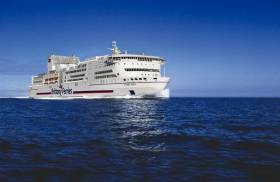Displaying items by tag: Brittany Ferries Pont Aven
Cork-Roscoff Ferry Uniquely Features 'Scrubber' Technology Part of €60m Green Fleet Investment
#UniqueIrishFerry - As previously highlighted on Afloat.ie, Jehan Ashmore reported on the planned installation of 'scrubbers' of Brittany Ferries flagship Pont-Aven during the winter which have since been installed prior to the cruise-ferry's return to open this year's seasonal Cork-Roscoff route.
The installation of the scrubbers (compare posting images) in essence are funnel emission reduction systems so to comply with the EU Directive on Sulphur Emissions.
Pont-Aven is unique in that she is the only ferry operating in Irish waters fitted with sulphur emission scrubbers. This is because the ferry also plies on the Roscoff-Plymouth route in the English Channel, one of several SECA (Sulphur Emission Control Area) geographical zones in northern Europe that are under the EU directive to curb on emissions. The Irish Sea nor surrounding waters are not subjected to the sulphur directive zones.
The work on the 2,400 passenger Pont-Aven mark towards the final phase in a major £60m environmental programme by Brittany Ferries to improve significantly the environmental performance of its six-strong car ferry fleet. The scrubbers on the flagship were installed at the Gdansk shipyard and engineers from the Polish yard will be fine-tuning the system over the next few weeks.
These vast and technically-complex exhaust systems strip sulphur from funnel emissions and significantly cut particulate output.
In terms of appearance, Pont-Aven's single uptake arrangement has been retained, however there is now a twin scrubber arrangement with one unit on each side of the original funnel.To disguise the emission technology a new screen wraparound structure (almost the width of the ship) forms this much larger new funnel.
Another cruiseferry Armorique which Afloat reported on while during a November crossing covering the Caen (Ouistreham)-Portsmouth route to enable Mont-St. Michel to have scrubbers installed in Spain at the Astander yard, has returned to the routine Roscoff-Plymouth route. Collectively, the investment on the Pont-Aven (which also operates UK-Spain routes) and Armorique is around £30m.
Scrubbers were also installed last year on the Portsmouth routes second ship Normandie. As for the scrubbers of Mont-St. Michel they too were engineered at the Astander yard located in Santander and the design allows passengers to see the complexity of the internal works for themselves.
"As a company we are proud of our reputation as guardians of the land and stewards of the sea," said Mike Bevens, Brittany Ferries group commercial director. "Today we are still largely owned by the collective of French farmers who launched the company more than 40 years ago, with the aim of linking territories and improving trade. These aims have always been framed by a will to respect the environments in which we operate and this significant investment is testament to our on-going commitment."
Barfleur, which sails the Poole to Cherbourg route and Cap Finistère which carries passengers across the wildlife-rich Bay of Biscay en route to Spain also benefit from the emission-reduction technology.
Cutting air quality emissions is just one way in which Brittany Ferries claim to be working to reduce the impact of its operations - and to support organisations that promote conservation work. The environmental measures are outlined below.
Cutting CO2 emissions while sailing
Brittany Ferries operations are planned to minimise fuel consumption, by reducing speed on overnight crossings. The effects of tides and the wind are also harnessed to optimise fuel efficiency.
Taking freight traffic off the roads
We are part of the motorways of the seas programme. Last year we carried nearly 200,000 freight vehicles. According to an EU calculation, the external costs of travel by sea are nearly four times lower than for freight transport by road.
Water discharge policy
All vessels are fitted with water treatment units. Only uncontaminated water is discharged to sea, and at a minimum of 12 nautical miles from the coast. Polluted water is stored on board, then taken to shore, to be disposed of by certified waste disposal contractors.
Using anti-fouling paints
Brittany Ferries uses the latest silicon-based anti-fouling paints to coat the submerged parts of hulls. These are low in toxicity and also enhance flow through the water, aiding fuel efficiency and thereby reducing CO2.
Low emission vehicles
On land we take our environmental responsibilities seriously too. Examples include our participation in the plugged-in fleets initiative in the UK, and through plans to include electric charging points for cars, for example at Portsmouth Port this year.
Conservation work
Our ships are taking part in the longest running marine biological survey in the world, towing continuous plankton recorders (CPR) for SAHFOS. We are also proud to work with whale and dolphin charity ORCA. Wildlife officers live on our ships throughout the summer to monitor and report on whale and dolphin sightings through the Bay of Biscay. This helps government fulfil its obligations under the Habitats Directive, but also supports conservation work to protect these beautiful sea creatures.






























































